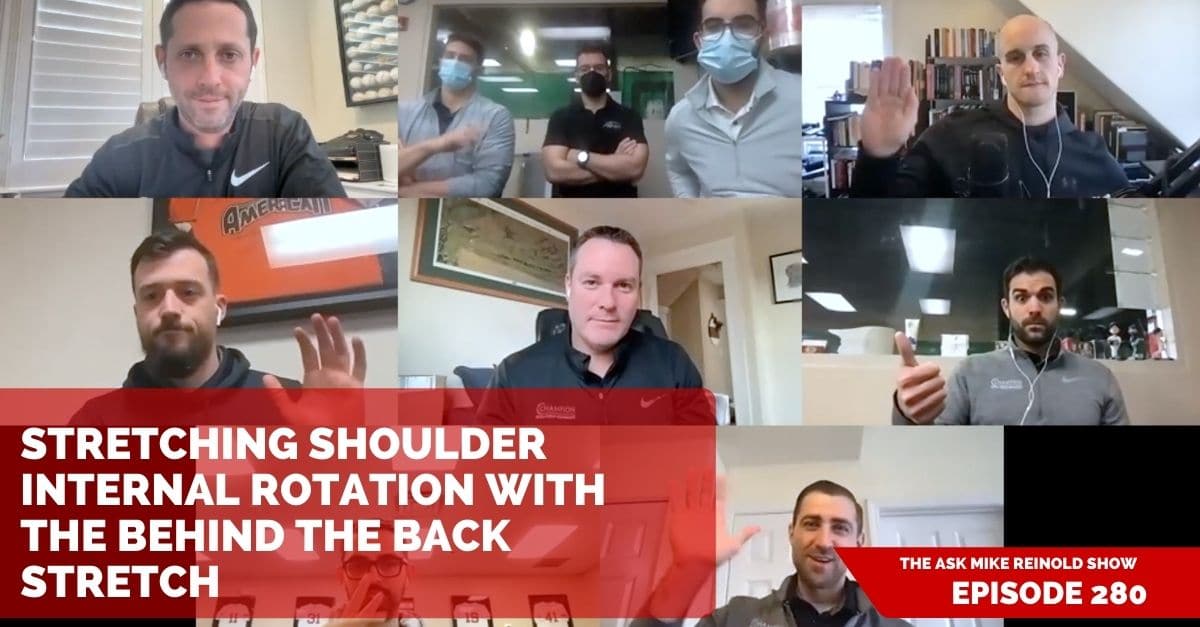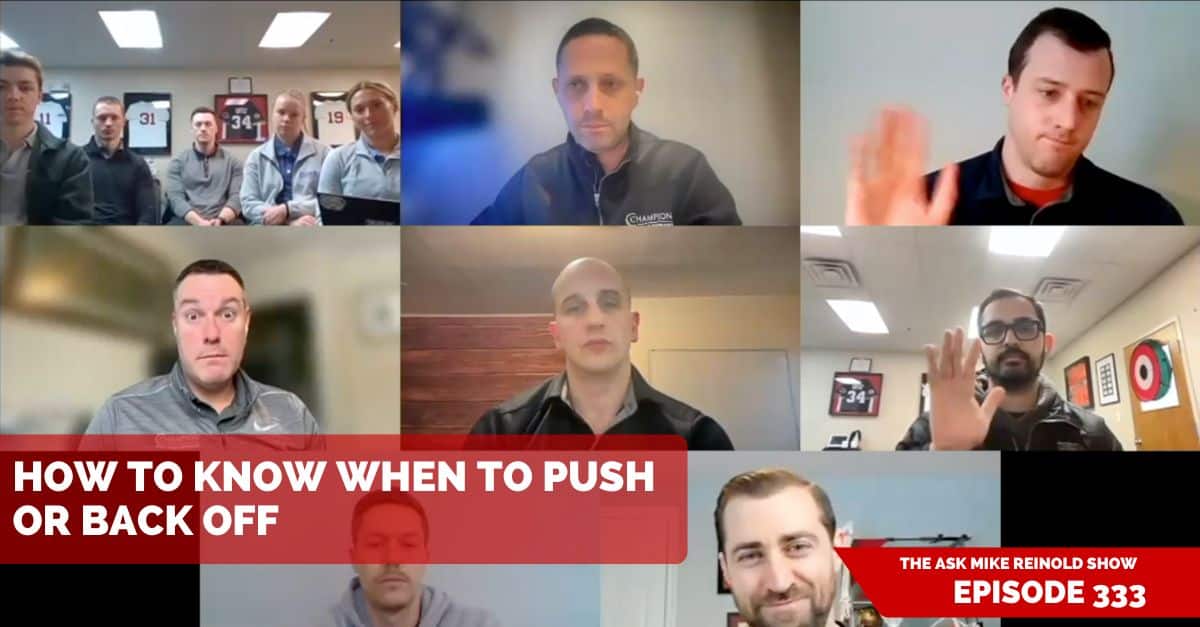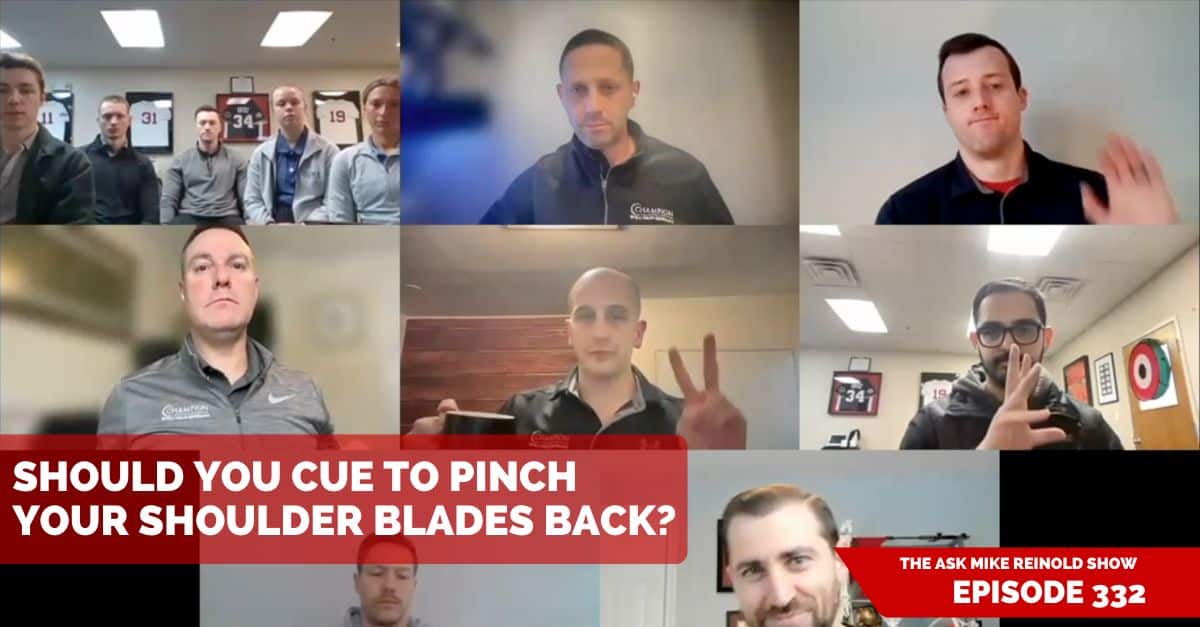Reaching behind the back is an important functional movement. Many assume it’s from a loss of shoulder internal rotation.
But if you’re limited in this movement, it can be more than just IR.
So we don’t often go to this stretch to improve internal rotation.
To view more episodes, subscribe, and ask your questions, go to mikereinold.com/askmikereinold.
#AskMikeReinold Episode 280: Stretching Shoulder Internal Rotation with the Behind the Back Stretch
Listen and Subscribe to Podcast
You can use the player below to listen to the podcast or subscribe. If you are enjoying the podcast, PLEASE click here to leave us a review in iTunes, it will really mean a lot to us. THANKS!
Show Notes
Transcript
Student:
So stretching shoulder internal rotation with the behind the back stretch. Jim from New York, I loved your shoulder course and podcast. This is my first question. I see both physical and occupational therapists treating shoulders, trying to regain internal rotation with the IR towel stretch behind the back. I’ve never been a fan of this and feel there are better ways to regain IR. What are your thoughts on trying to regain IR with the towel up the back stretch?
Mike Reinold:
Yeah, I feel like you’re ready to fight somebody right now, Eric. Is that a Long Island thing?
Student:
I think so.
Mike Reinold:
I love it. I love it. I mean, that’s why this question from Jim from New York, I figured, he’s probably saying it with that same accent and stuff. So the two of you in a conversation would be amazing. So, all right. So, behind the back towel stretch. Who wants to start on this one? I actually have some blog posts on this, too, that you can Google around here, but that’s certainly not a stretch that we do at Champion. I don’t think anybody does it. If we saw somebody doing it, that would probably go poorly. But we’d have a little chat about that, but I get the concept of this, right?
Mike Reinold:
Functionally, a lot of patients, especially older patients and bigger surgical procedures, they complain functionally that they can’t do activities behind their back. So gentlemen reaching in their back pocket sometimes, right? Going up the back and females is a common complaint that they talk about. They talk about how that’s super awkward. So people, give them a towel and say let’s tug on it. Let’s torque this thing. Who wants to start this one on, we’ll just get right to it and say why we don’t use it. Right? Because I think that’s an important thing to talk about who wants to start? What’s up, Dave?
Dave Tilley:
I think this is a good example of a summary content that we use a lot and I learned from Mike and Lenny when I first started is you can have someone who is like stiffness from a muscular point of view, but then has some laxity or looseness from a joint point of view. And I think oftentimes what we’ve seen in a lot of these patients in this joint and others is that sometimes when someone is lacking motion from a soft tissue point of view, they make up for that motion by maybe putting more stress on the joint capsule, or maybe putting some extra stress on areas that maybe don’t really like it too well. And this is a really good example. To get your hand behind your back you need to get extension, but also IR of that motion. So sometimes we see people who have lacking IR from a soft tissue point of view or a stiffness point of view, but they’re continuing to do the motion they want to get.
Dave Tilley:
And what happens is they make up that motion by putting some extra stress on the front of the shoulder. And you see someone when they you look from the side, if they’re doing this, they have a lot of anterior glenohumeral migration, right? So they have a lot of forward motion of their shoulder and it maybe feels uncomfortable in the front of their joint capsule or maybe they’re stressing a cuff tendon or a bursa or something. So, sometimes it’s a little bit better to break down that motion into pieces and figure out maybe which one of those components is not there that you’re trying to find, or maybe the IR, right? Or maybe some T spine extension someone’s lacking to get that hand in the right position. So it might be a better option to check the pieces rather than just keep fixing the entire motion as a whole.
Mike Reinold:
Yeah. I think that’s a great way of saying it, the body is going to take the path of least resistance. Right? So if you’re tight I think one of our general concepts is if you are limited with your range of motion, we don’t bring you to end range and then push it further. Right? That seems weird, right? So, Hey, you don’t have overhead flexion, just keep jamming it up until it goes. It’s not the way that we to regain motion. So great point, Dave, I like that. Dan, what do you think?
Dan Pope:
I think sometimes this is a clinical reasoning problem, right? One of the reasons why people can’t get their hand behind their back is because it hurts to do so. And they’re not necessarily super stiff per se. So you have docs that take a look at the range of motion. Hey, you need to work on this. You need to push it. And this happens to me every once in a while. You’ll have a patient that comes in, can’t reach behind their back. And the doctor says, Hey, you got to start working on this and gives them basically the towel behind the back or something along those lines, when probably the reason why they can’t do this, because it hurts so bad. Right? So I don’t know that trying to push into provocative position is necessarily going to help. It may, potentially. Maybe you’re arguing, you’re making that tissue adapt over the course of time. But I think the other piece is that it’s not going to get you better if you keep on pushing through enough pain that it irritates it further and it may affect other parts of rehab. So I think first and foremost, make sure they actually have a range of motional limitation. You’re not just pushing into a provocative position because they’re too fresh out from a given surgery.
Mike Reinold:
Really well said, too. And if you break down behind the back, what I think is worse is when people say, that shoulder has limited internal rotation, so I’m going to give them behind the back stretch. I get it if functionally the person can’t reach behind their back and you’re trying to improve that. I get that. I still don’t necessarily perform that stretch. But to say that that’s an internal rotation stretch, to me, I think is a little misleading. So if you actually look at that, Dave alluded this there, that is shoulder extension adduction and internal rotation. And it’s funny. I wrote this down on a blog post, many years ago. But if you actually look at that, the majority of internal rotation at the shoulder occurs by the time you get to the sacrum and that’s not where people are tight, right?
Mike Reinold:
They’re tight as they try to go up their back. So it’s not even internal rotation. A good third of the motion is probably scapular, thoracic, anterior tilt and dumping. Right? And the rest of the motion is shoulder extension in adduction. Right? I think if anything, what this shows us isn’t that we’re bad at increasing internal rotation after our surgery. I think it probably shows us more than anything else that extension is the thing that we’re bad at working on. Right? We don’t work on extension enough, maybe. Or the surgical procedures that we tend to see a rotator cuff repair or ansura capsular labral tear, those types of things that capsular shift. They’re all in the front, those things all limit extension surgically. They’re designed to do that, intentionally. Right? So that’s how it goes together in there.
Mike Reinold:
So to me, I don’t know if it’s even internal rotation that does it. There’s other studies that have been published that there’s a very low correlation between internal rotation measurements and your ability to reach your arm behind the back. Right? So keep that in mind with all those things. So I don’t know. We are answering the question, right? But I always like alternatives. Right? So I think we should provide that in that episode. I think we’ve all said a good case as to why not. Who wants to jump in, maybe we hear from somebody new. What would you do different? What would you do different, Mike, to actually get that arm behind the back better?
Mike Scaduto:
I would definitely, it starts with your assessment trying to figure out if it’s a capsular limitation or if there’s a soft tissue component as well. Most likely, it’s probably a combination of both. And we know that working on the posterior cuff can help improve internal rotation. So I’d probably do some pin and stretch to the posterior cuff, infraspinatus, even teres major, can work on that a little bit as well, working in the cross body motion, you can do a contract, relax, cross body stretch, where you’re stabilizing the scapula, stretching out the posterior cuff and maybe getting a little bit of a capsular stretch and that can help improve internal rotation. That would be my first go-to from a soft tissue perspective. And then working on thoracic extension and scapular control exercises, I think could also help improve internal rotation.
Mike Reinold:
It’s a great point, too. And I think from what I heard from Mike, let’s look and see what’s actually limited in that person. So if they’re limited in adduction, horizontal adduction, or adduction of the shoulder, then they’re going to have a limitation in reaching up their back. But just work on the adduction, right? Don’t just jam their hand up their back, work on that one movement pattern, right? Work on thoracic position, work on scapular position, work on soft tissue before you just getting the end range of torque. I think that’s a great way to do it.
Lenny Macrina:
I think we get. I think there’s a time and a place, too. You can’t be doing this at eight weeks out of a rotator cuff repair. Right? I think you got to allow, because you said it. I think you said why this is happening a lot in our shoulder patients is the tissue that it was repaired is gets stressed when you get into these positions. So I think we mentioned in previous episodes, you got to give this tissue at least three months to incorporate again, depending on the age of the person and the health of the person, at least three months to incorporate before you start thinking about the behind the back aggressive type position that they’re trying to get to. If they are trying to do that and it’s too early, I’d probably tell them to stop that. Figure out a different way to live. If it’s a female, all the bra situation, putting a bra on, you try to figure out a different way. Can you attach it in the front? Can you get a different style or just refer to my female therapist and give me some help. But I think there’s other ways around it and not stress the tissue because you risk re retearing it. So you got to be careful how you are, when you’re being and putting these people in these positions to get that range of motion back.
Mike Reinold:
What the number one thing we hear from cuff patients in terms of how they think they injured their shoulder that put them over the edge. It’s reaching for your brief briefcase in the back of the car and…
Lenny Macrina:
Hauling luggage or reaching in the backseat. That’s a common thing. Of course.
Mike Reinold:
What else, Dan, did you have something too?
Dan Pope:
Yeah, I think Dave could probably speak to this as well, but I worked a lot of folks are trying to get back to end range extension. Just because people are trying to do, let’s say a bench press, but even more like a dip or ring muscle ops, that type of thing. You need a ton of extension for those things. So I don’t feel like there’s a whole lot of information out there on how to improve extension range of motion. So we do a bunch of drills. You treat it similar to any other area where you’re trying to gain range of motion. I think at least at the shoulder, you probably want to target the soft tissues in the front of the shoulder to help with extension range of motion. So maybe you’re working a little on the delt, a little in the peck, over the course of time as they can handle it. You’re doing some extension range of motion. Maybe start with something like a PVC pipe. Then I start doing some close chain exercises. So an assisted dip. I’ll even do some dips slowly with the pauses at the bottom. So we’re working on slowly rebuilding that extension range of motion. But I think if you couple that with internal rotation, like you said, you’re going to have a lot of success. You have to slowly do it.
Mike Reinold:
I think you nailed it there. And I think if we had to critically assess all of what we do and even like all the protocols that we’ve written over the years, we don’t talk about shoulder extension that much. We really don’t, it’s not included in a lot of those things. So that’s probably an area we can improve on. I’ve started spending more and more time on that. With my capsular or labral repair type people, just working behind their body a little bit and just with passive range of motion, bringing them to end range and telling the tissue like, Hey, this is the load that I want you to feel here. Some stress that I want you to get. And I think over time my outcomes have gotten better to remove that stiff period that sometimes a lot of them go through.
Mike Reinold:
I think you’re right. I think maybe focusing on some, some gentle extension range motion versus waiting till 12 weeks and being, oh man, it’s tight. Grab this towel and torque the crap out of your shoulder behind your back. Right? To me, that just seems the wrong approach. So. Awesome. All right. So great episode, hopefully that kind of helps a little bit. Dig around on my website. I think I have. I do think I talked specifically about the behind the back stretch in, in one post, but I have lots of other things on, on how to increase internal rotation. And I think that is really what we tend to focus on more than anything else. So. Awesome. Great question.
Mike Reinold:
Thanks so much. If you have a question like that, head to mikereinold.com, click the podcast link and you can fill out our form to ask us anything you want to talk about. We’ll do our best to get to them. And please head to Apple Podcast, Spotify, rate, review, subscribe. We’ll see you on the next episode. Thanks again.





